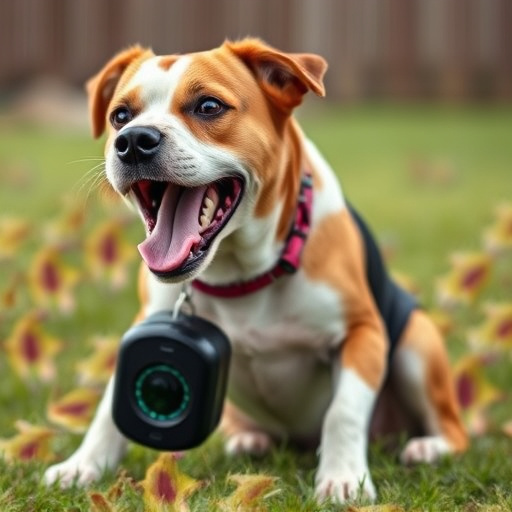Dogs' diverse personalities require tailored training methods, making ultrasonic electronic dog deterrents a humane and effective solution. These devices emit inaudible high-frequency sounds within a 10-meter range to startle dogs, discouraging unwanted behaviors like barking or jumping. For optimal results, these deterrents should be used closely with their range adjusted to specific needs. A Canine Behavior Modification System combines an ultrasonic EDD with remote controls and apps for discreet training. Safety and proper training are crucial; understand the device's effective distance and use positive reinforcement alongside the deterrent to help dogs learn desired behaviors while avoiding overstimulation or stress in sensitive environments.
“Unleashing the Power of Sound: Exploring Canine Behavior Modification with Ultrasonic Systems”
Canine behavior modification has evolved, incorporating innovative tools like ultrasonic systems to address training challenges. This article delves into the world of electronic dog deterrents, examining their effectiveness at varying distances. We’ll explore how these systems utilize sound waves to guide canine behavior while ensuring safety and ethical considerations. Understanding the mechanisms behind these devices offers valuable insights for dog owners seeking effective, distance-specific solutions.
- Understanding Canine Behavior and the Role of Ultrasonic Systems
- How Effective is an Electronic Dog Deterrent at Different Distances?
- Components and Functionality of a Canine Behavior Modification System
- Training and Safety Considerations for Using Ultrasonic Deterrents on Dogs
Understanding Canine Behavior and the Role of Ultrasonic Systems
Dogs, much like humans, have unique personalities and behavior patterns that can greatly vary from one canine to another. Understanding these behaviors is essential in training and modifying them. Canine behavior modification often involves identifying triggers for unwanted actions and using positive reinforcement or other techniques to teach alternative behaviors.
Ultrasonic systems have emerged as a non-lethal, effective electronic dog deterrents, with an operational range of up to 10 meters (32 feet). These devices emit high-frequency sound waves that are inaudible to humans but can startle or discourage dogs from certain actions, like barking excessively or jumping on people. By utilizing the principle of negative reinforcement, ultrasonic systems train dogs subconsciously without causing them harm, making them a preferred choice for pet owners looking for a humane and effective dog behavior modification tool.
How Effective is an Electronic Dog Deterrent at Different Distances?
The effectiveness of an electronic dog deterrent, often using ultrasonic sound technology, varies significantly with distance. These devices emit high-frequency sounds that are unpleasant to dogs, aiming to correct unwanted behaviors like barking or aggression. At close ranges, typically within a few meters, they prove highly effective, as the intense frequency can startle and redirect the dog’s attention immediately.
As you move further away from the device, its impact diminishes. Beyond 10-15 meters, the sound pressure level decreases considerably, reducing its ability to deter or correct behavior. Thus, for optimal results, these electronic deterrents should be used in close proximity to the dog, and their range should be carefully considered based on the specific application and environmental factors.
Components and Functionality of a Canine Behavior Modification System
A Canine Behavior Modification System typically consists of several key components designed to work in harmony for effective training and behavior control. At its core, an Electronic Dog Deterrent (EDD) device stands out as a primary tool. This device operates on ultrasonic waves, emitting high-frequency sound that is inaudible to humans but can be detected by dogs. The EDD is engineered to deliver a gentle but effective correction when the dog displays unwanted behavior, like barking excessively or jumping on people.
The system often integrates with remote controls or smartphone apps for easy operation and monitoring from a distance. This allows pet owners to correct behavior discreetly and consistently without being physically present. Additionally, some advanced systems include sensors that detect specific behaviors, such as barking or movement, triggering the EDD automatically. This automation enhances the responsiveness of the system, making it more effective in modifying canine behavior over time.
Training and Safety Considerations for Using Ultrasonic Deterrents on Dogs
When using ultrasonic deterrents for canine behavior modification, safety and proper training are paramount. These devices emit high-frequency sound waves that remain inaudible to humans but can be effectively perceived by dogs as an unpleasant sensation. To ensure their safe use, it’s crucial to understand the effective distance of these systems—typically around 30 feet (10 meters)—and adhere to manufacturer guidelines strictly. Training should involve positive reinforcement techniques alongside the ultrasonic deterrent to help dogs associate the sound with specific behaviors or commands, making them more receptive to modification.
Pet owners and trainers must also be mindful of potential sensitivities in dogs’ hearing, especially in puppies or breeds with a history of auditory issues. Regular breaks during training sessions are essential to prevent overstimulation. Additionally, using these devices in environments where other high-frequency noises might coexist can help maintain their effectiveness without causing unnecessary stress to the canine participant.
The canine behavior modification ultrasonic system presents a unique approach to addressing problematic dog behaviors, with its effectiveness varying based on distance. While electronic dog deterrents have proven useful at close ranges, their impact diminishes significantly beyond 30 feet. To ensure safety and positive reinforcement, proper training is essential for dog owners and trainers alike. Understanding the technology’s functionality and implementing thoughtful training methods can help create a harmonious environment for both pets and their owners.
